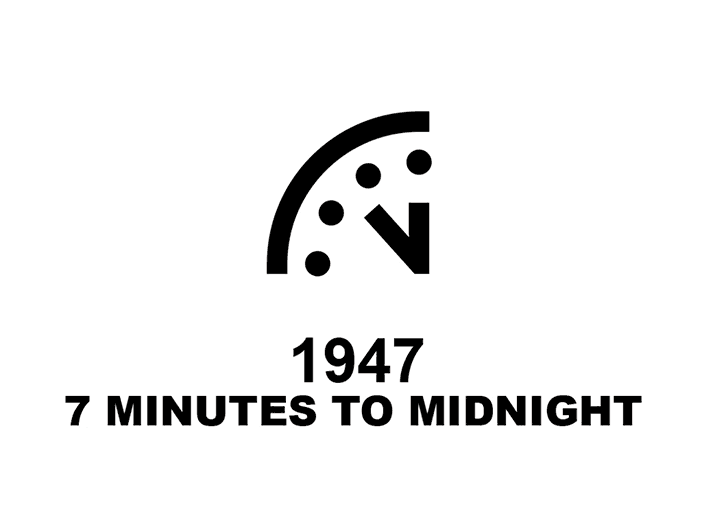News•January 22, 2015
Climate Change Moves the Doomsday Clock

By Brian Kahn
The end of civilization as we know it just got a little closer. According to an update to the Doomsday Clock, the world is now three minutes from midnight and one of the big reasons is the failure to reduce greenhouse emissions even in the face of climate change.
Credit: The Bulletin of the Atomic Scientists.

The Bulletin of the Atomic Scientists maintains the clock and resets the hands every few years based on existential threats to civilization. Created in 1947, the clock initially served as a warning about the threat of nuclear weapons, but climate change has started to mess with the hands of time in recent years. This is the fourth update to the clock that explicitly mentions climate change, though it’s an issue that has been on the Bulletin’s radar since 1961.
The clock was last updated in 2012, when the hands were set at five minutes to midnight. The reason the world is closer to doomsday now is the growing clarity about impacts of climate change, including some already occurring, and the failure to address it.
RELATEDPentagon: Climate Change Poses ‘Immediate Risks’
A Broken Record: 2014 Hottest Year
Haiyan Foretells Challenges for Military in Warming World
“The reason we feel greater sense of urgency on the climate issue is quantitatively, if you want to limit climate change to a certain magnitude, you’re only allowed to have a certain amount of carbon dioxide in the atmosphere. We’re about halfway there,” Richard Somerville, a oceanographer at Scripps Institution of Oceanography and a board member of the Bulletin, which maintains the clock, said.
If emissions continue on their current trend, they’ll likely expend the carbon budget — a term used by scientists to describe how much carbon dioxide can be emitted while safely keeping the world from warming more than the 2°C (3.6°F) — in three decades.
Passing that threshold could lead to higher sea levels, an increased rate of ocean acidification, and rising global temperatures at rates that some scientists think could be beyond society’s ability to adapt. Beyond those direct impacts, climate change also poses a threat multiplier problem for the military by potentially increasing migration, destabilizing governments and increasing regional conflicts. The Pentagon already views climate change as an “immediate risk.”
Sivan Kartha, another Bulletin board member and senior scientist at Stockholm Environment Institute, said that international climate treaties have weakened in the 20 years of major negotiations with most emissions cuts going from binding to voluntary and emissions cuts failing to come close to staying within the carbon budget.
The only time the Doomsday Clock has been closer to midnight was in 1953, a year after hydrogen bombs were tested by the U.S. and Soviet Union in an escalating nuclear arms race. The clock also struck 11:57 p.m. in the Cold War chill of 1984. On the positive side, the clock was moved all the way back to 11:43 p.m. in the wake of the Cold War and the start of nuclear disarmament.
What’s keeping the clock from striking midnight now is that despite little to no action on climate change, solutions do exist. Namely, that means transitioning away from fossil fuels toward renewable energy.
“The IPCC concluded unequivocally that we can shift away from fossil fuels to low-carbon energy resources. Moreover, we can afford to do this,” Kartha said, noting it would shave just a fraction of a percent off project global economic growth, which “means instead of global GDP doubling in say 25 years, it would double in 26 years.”
Some countries have started that transition but Kartha said more efforts are needed and that the coming climate negotiations in Paris later this year could be a crucial turning point.
In the meantime, the clock’s ticking.
You May Also Like:
U.S. Coal Declines, Bucks Global Trend
Watch 28 Years of Old Arctic Ice Disappear in One Minute
Heat Stroke, Anyone? Tennis Grand Slams Heating Up
After December Rains, California Comes Up Dry